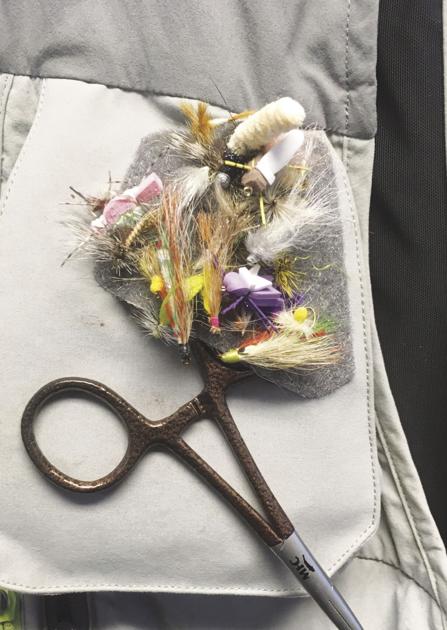At the end of each trout season, before putting away my fly vest, I take the opportunity to do a cleaning and an organizing. This is not a drawn out process. Sorting leaders and tippet. Checking floatant bottles. Cleaning out fly boxes.
Fly vests have morphed over the years. They became packs. They became slings. They became combinations of all three. But there is one constant of whichever one you choose to hold your gear: the fly patch.
Now, fly patches have morphed as well. They started out as a square of lamb’s wool. Then synthetic fleece. Then foam. And now Velcro. Yes, the new fly patches are the sticky side of Velcro.
This is where anglers get stuck organizing their vest for winter. During the season, the fly patch acts as storage when on the water and changing flies. A fly patch that started barren in April is now covered with flies. Each fly has a story. Stories that the fly patch will retell as you remove the fly and place it back into the fly box for the fly’s winter nap.
My wife says that my fly patch looks like my sock drawer. Actually, the sock drawer is more organized. There are so many flies on the patch of my Orvis Ultralight Fly Vest that you can barely see the Velcro.
The Light Cahill is from an evening spent on the Wildcat River. There is a great late summer Light Cahill hatch and the native brook trout go crazy for that fly. One of the highlights of the summer of 2020.
The MOP Fly is from a morning spent at Goodrich Falls. Smaller trout were taking Tricos on the surface, but I had other plans. The bigger trout hug the bottom of the Falls. Getting a fly down to them is the only chance at a hook up. The fishing was slow but a nice 14-inch brook trout came to hand.
The Stoneflopper drove the brown trout crazy one night on the Saco. Being a foam bodied fly, it floats like a cork. It can imitate a stonefly or a grasshopper. This one was fished in the dead of summer and was responsible for the largest brown trout of the season.
A Pink Blingnobyl Ant was just the ticket for a morning at First Bridge and the rainbow trout. The fly imitates nothing. It is the poster child for the expression “trust your fly.”
A Hendrickson Flymph started the catching on the Saco in the Spring. Hatches were late this year and an emerger pattern was necessary for the early season trout.
The Pink Lady wet fly ruled the trout on Saco Lake one June evening. This version had a calf tail wing to replace the mallard quill. Calf tail is tougher against the brook trout’s teeth. It was necessary on that night.
An experimental White Muddler Minnow provided action on several waters throughout the season. The biggest fish was a 15-inch wild brook trout in a remote pond.
Purple proved to be a winning color this season and the Purple Transfoamer was just the ticket on rivers and ponds. Some very explosive takes happened with this fly.
The Pink Lady Bucktail. You already know that tale.
And finally, two Little Brook Trout Bucktails. One has the tinsel missing. The other has a jungle cock eye. So many fish came to hand fishing this classic.
Check the hooks when taking flies off your fly patch. Any hooks with rust should be filed clean before putting into winter storage.
Steve Angers, a native to the Conway area, is the author of the book “Fly Fishing New Hampshire’s Secret Waters” and operates the North Country Angler.
Credit: Source link































